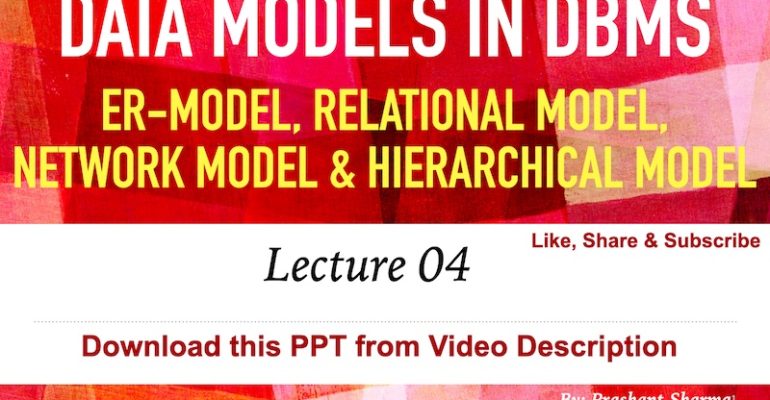Different Data Models in DBMS, ER Model, Relational Model

Different Data Models in DBMS, ER Model, Relational Model
Download Presentation
 Loading...
Loading...
What is Model & data Model?
A model is a representation of ‘real world’ objects and events, and their associations. Models helps in abstraction that focuses on the important details & ignores the other aspects of the system
Data models define how data is connected to each other and how it is processed and stored inside the system.
The purpose of a data model is to represent data and to make the data understandable.
Components of Data Models
STRUCTURAL PART
It consists of rules that define the database and its structure
MANIPULATIVE PART
This part contains the type of operations that are allowed on the data eg. insertion, deletion, update etc.
INTEGRITY CONSTRAINTS
This part contains the set of constraints to make sure that data is accurate & valid.
Object based data models
Object based data models use Entities , Attributes & Relationships to describe the model.
ER-Model
Entity : An object (person, place, thing, concept, event) which is of some importance to an organization
Attribute : It describes the entity i.e. properties of an entity that is to be recorded.
Relationship : Association between the entities.
Record Based Data Models
Record based data models are based on fixed format records consisting of number of fields.
Relational Model
Relational Model is based on mathematical relations.
In this model data and relationships are represented in the form of tables, each of which has number of columns with unique name.
Users see the whole database in the form of tables. Such representation is only limited to the external and conceptual levels.
Relation : Tables.
Tuple : Single Row.
Key : Can be single or multiple attribute which
establishes & identifies relationships.
Attribute Domain : Value Scope of Attribute
Hierarchical Model
In this model data is organized in a tree like structure.
In a hierarchical database, an entity type can be either a parent or a child; under each individual entity is more multiple entities.
Entity types are related to each other using tree mapping, which is represented by one parent with many child relationships. There are also attributes of a specific data recorded under an entity.
Network Model
In this model data is organized in a tree like structure and it is the enhanced version of hierarchical model.
This data model is also represented as hierarchical, but this model will not have single parent concept. Any child in the tree can have multiple parents here.



